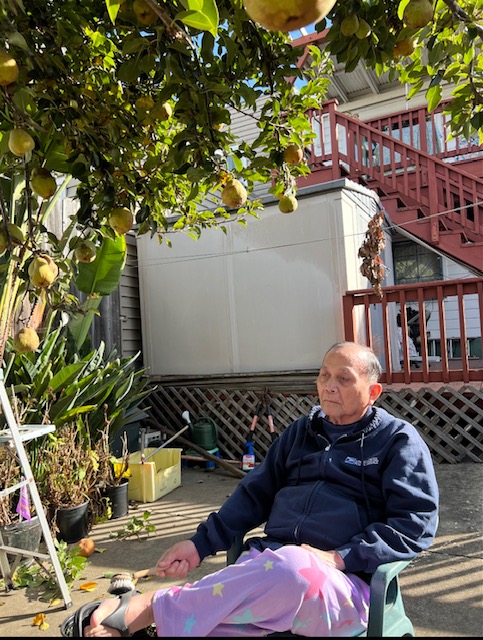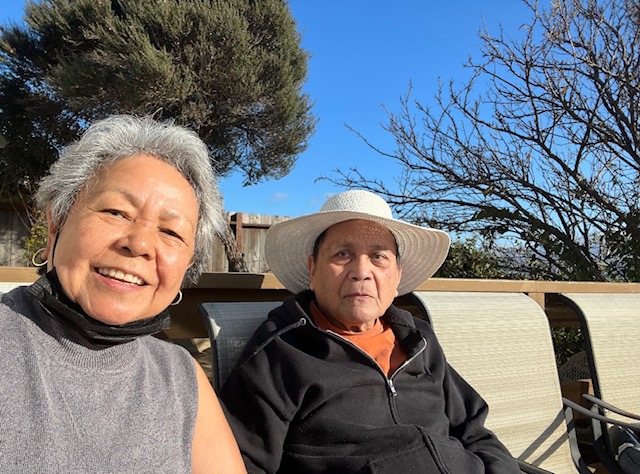By Justin Mendoza
The year was 2012. It has been two years since Rodolfo Reyes retired from the United States Postal Service. He was enjoying life. He often wondered when his wife, Cora, would retire, too.
But it was the same year when Cora began to notice something different.
“I had to repeat myself a lot to him when he has questions. Or when he says something, it gets repetitious,” she said.
LATEST STORIES
One day, Cora, now 75, was with Rodolfo, 77, at his regular doctor’s appointment. She told the doctor she had to repeat things to him at home. The doctor ran a few tests and sent them to a neurologist.
A few more tests later, the neurologist confirmed Rodolfo was experiencing the early stages of dementia.
“It was heartbreaking,” she said.
The Centers for Disease Control and Prevention says dementia is a general term for the impaired ability to remember, think, or make decisions that interfere with doing everyday activities. The CDC says Alzheimer’s is the most common type of dementia. Though dementia mostly affects older adults, it is not a part of normal aging.
The Alzheimer’s Association says there are several factors that could cause Alzheimer’s. Genetics, lifestyle and the environment could play a role.
Dr. Marina Martin, clinical associate professor of medicine and clinical section chief for geriatric medicine at Stanford says the most important symptom is short-term memory loss.
This includes the difficulty forming new memories and remembering things that happened recently, she said to AsAmNews.
Long-term memory often stays in place longer. “People may remember things pretty well from their childhood or earlier life, but have trouble remembering things that happened more recently or things they’re supposed to do that week.”
She adds memory loss could be more noticeable to other people than it is to the patient themselves. “That’s really not uncommon that the person is not able to see it in themselves as much as their family or close friends.”
When Rodolfo was diagnosed with dementia, Cora said he was in denial.
“He doesn’t believe that he has that problem. I was sad,” she said. “It’s hard because you already know what’s gonna happen in the future.”
Cora said the neurologist had to report his condition to the Department of Motor Vehicles.
According to the California DMV, drivers diagnosed with dementia must be reexamined through a driver safety knowledge test. If they pass, follow-up exams are required to reassess the progression of dementia.
DMV warns drivers could be unaware of the severity of the disease. Ultimately the state could revoke a driver’s license if a dementia patient’s mental and physical abilities are significantly impaired.
Cora said Rodolfo did not want to retake the driving tests. Once his driver’s license expired, Rodolfo stopped driving.
And driving is what Rodolfo knew very well. He worked as a truck driver for 25 years at the U.S. Post Office before retiring in 2010.
“That is his profession. And like all of a sudden his license will be taken away. I felt so bad for him.”
The same year the couple got the dementia diagnosis, Cora decided to retire from her job in the sales audit department at See’s Candies-her job for 12 years.
“I wanted to work forever,” Cora said, before her husband’s diagnosis.
Rodolfo, who wondered when he’d spend more time with his wife after his retirement just two years prior, would now face something new with his wife of 42 years; embark on a new chapter as they face the uncertainty of how Alzheimer’s would impact their lives.

The National Impact of Alzheimer’s
More than six million people are living with Alzheimer’s in the U.S., according to the latest numbers from the Alzheimer Association.
Latest numbers from the National Library of Medicine recorded 121,499 deaths from Alzheimer’s Disease in 2019 making it the sixth-leading cause of death in the U.S. Data also shows between 2000 to 2019, deaths from stroke, heart disease and HIV declined, while Alzheimer’s deaths increased by 145%.
The Alzheimer’s Association says the number of diagnoses is expected to rise to 13 million by 2050.
Alzheimer’s and the Asian American Community
Asian Americans are less likely than other groups to have Alzheimer’s, according to the Alzheimer’s Association. Only 18% of Asian Americans are aware of mild cognitive impairment which can be an early stage of Alzheimer’s. This can make it harder for individuals or families to notice the symptoms and seek professional care.
Benson Zhao, community engagement manager with the Alzheimer’s Association in San Francisco says the AAPI community is less likely to get an early diagnosis of the disease. Some factors include not wanting to discuss the early signs and cultural stigma.
He says an example in Chinese culture, “we translate that disease name as like a crazy old person” and “mental disease over your craziness.”
Zhao says this affects how families recognize it and how they deal with it as well.
Zhao says some Asian American Pacific Islander, or AAPI, families don’t seek professional help right away underestimating the emotional, physical and financial burden.
Dr. Martin also says anybody with dementia and low English proficiency could struggle to manage the health care system. “It’s complicated.”
“If you have both cognitive impairment and low English proficiency that are making it hard for you to interact with the health care team and get the help you need, that’s kind of a double whammy.”
She advises having an interpreter will be very helpful, but could possibly be a burden on the family, since…on top of managing the patient, they have to know the loved one’s medical history for doctors and nurses.
Cora and Rodolfo: Before Alzheimer’s
Cora and Rodolfo Reyes live in a suburb south of San Francisco known as Daly City. Both immigrated to the U.S. from The Philippines—-but at different times. Rodolfo joined the U.S. Navy in 1964—and served for 20 years. Cora moved to the U.S. in 1969.
It was one weekend in Vallejo, California in May 1970 when their paths crossed, thanks to mutual friends. Six months later, they were married.
“I was spoiled wife,” Cora said. “He cleaned the house. First thing in the morning, he fixes our bed. He prepares breakfast.”
“He’s a good human being,” she says, describing who her husband was before his diagnosis.
Cora says Rodolfo kept things clean and tidy around their home.
“He takes care of everything. Every minor thing that’s a problem in the house, he fixes it.”
She says her husband was also into the holidays. She remembers he would buy Halloween and Christmas decorations and decorate their home.
Cora and Rodolfo have two children, Alex and Laarnee, and four grandchildren. Alex is married with children and lives in the Bay Area. Laarnee is also married with kids and lives in Southern California.
Prior to the dementia diagnosis, their lives were like any other family. Eating out, celebrating birthdays, and even going on cruises with friends and playing at the casino. Cora shows pictures of Rodolfo participating in the “Bay to Breakers,” an annual seven-mile footrace in San Francisco.

She says he often exercised and read books, too.
Cora says Alzheimer’s runs in Rodolfo’s family. His older sister is currently living with the disease in the Philippines. His younger sister in Los Angeles passed away from Alzheimer’s complications a few years ago.
According to the Alzheimer’s Association, family history is not necessary to get the disease. But research shows people who have a family member such as a parent or sibling with Alzheimer’s, are more likely to get the brain disease.
Cora and Rodolfo: Alzheimer’s
After Rodolfo’s diagnosis, Cora began to notice things. After he cleans, the cleaning supplies would be misplaced around the home. Another time, she says he misplaced the remote by putting it his pocket.
“I start kind of watching so I know where things are.”
Cora points out a time when Rodolfo was in the early stages of his dementia when they went to the bank since it was reminiscent of them going to the casinos.”I wanted him to be happy.” She gave him a withdrawal slip, and he withdrew $1,000. She says he counted ten one-hundred dollar bills at the teller window.
When they arrived home, he showed her $300. “What happened?,” she asked.
“This is all I have,” Rodolfo said, according to Cora. She was worried. Cora later found the rest of the money in between two pictures wrapped in scotch tape. She says he didn’t remember putting the money in there.

A few years after Rodolfo retired from the U.S. post office, he and Cora were at Costco one day. She ran into their friend and his former co-worker, whom she says was his colleague for 25 years.
“Come here, come here. Let’s see if Rudy will recognize you.”
She said Rodolfo did not remember him.
Despite her husband’s diagnosis, she wanted to make the most out of life. Cora took Rodolfo to The Philippines, Amalfi coast, a Mediterranean cruise and Hawaiian cruise.
Everything went well at some vacations. However, in later trips, there have been situations where Rodolfo got lost whether it was walking off or not knowing his direction after leaving the restroom.
Several years after the diagnosis, Cora noticed Rodolfo began to not always say her name.
Instead, he’d call her “jo” meaning “friend” in a Filipino dialect.
In recent years, Cora says Rodolfo has had a hallucination. She says he talked about how a neighbor spent a lot of money on a swimming pool—-except there is no pool. Just a long yard with some trees, she said.
Cora learned from an Alzheimer’s support group hallucinations could happen with Alzheimer’s. “He sees something that’s not there,” she said.
Hallucinations are possible with a person who has Alzheimer’s, according to the Alzheimer’s Association.
The person may see, hear, smell, taste or feel something that isn’t there. The false perception is usually caused by changes within the brain that result from Alzheimer’s in the later stages of the disease.
Over the years after the diagnosis, Cora cooked Rodolfo’s meals, prepared and gave his medications and watch him take his baths.
Someone’s Diagnosis
When someone is told they have dementia, it’s no doubt life changing. Shocking. Scary.
“Work on developing a support system, both to help with the stress and strain of the diagnosis, because it can be very upsetting,” Dr. Martin said.
“Also put into place people who can help with managing things that may become difficult to manage, including finances and health care decisions down the road,” she said.
This would help make sure a person could be well cared for as time —-and the disease—-progresses.
Dr. Martin also says exercise and maintaining social connections are important, and could potentially slow down the progression of Alzheimer’s.
“We’ve seen with the isolation from the (COVID-19) pandemic… a lot more rapid progression of cognitive impairment.”
Caregiving: The cost, the impact, the help
Cora is one of the more than 11 million Americans providing unpaid care for people with Alzheimer’s or other dementias, a caregiver statistic by the Alzheimer’s Association.
“Some (Asian American) families really feel strongly that they want to keep their loved one with dementia in their home, in their family, and provide care in the house,” said Dr. Martin.
Asian Americans and Pacific Islanders are more likely to take over caregiving roles for an older adult compared to the general population, the Alzheimer’s Association says. They are also more likely to have multiple family members involved in care or decision-making, rather than just one person.
For Cora, when she learned of Rodolfo’s diagnosis, she felt pity that he got this dreaded disease. But as his wife and caregiver, she never felt depressed. She told herself to stay healthy for him and step up to the plate.
For other family caregivers, it could be a 24-hour job.
“Caring for somebody who has Alzheimer’s disease, it can be a 24-hour job, if they need supervision for safety, and might have some of the common complications of dementia that affects their behaviors, their moods and their sleep,” Dr. Martin said.
She says fatigue and stress-related issues are more common in caregivers for people with dementia.
“That can include mood disorders, people struggling with anxiety or depression or sleep disturbance. Or it could be worsening of other conditions that are sensitive to stress like gastrointestinal problems, blood pressure or heart disease.”
“My advice is that nobody with Alzheimer’s should be cared for by only one person,” Dr. Martin said. “And I realized that that can be very difficult if there are financial limitations to getting help. But there are programs out there that can help people to hire caregiving help.”
She strongly encourages caregivers to reach out to local senior centers or the Alzheimer’s Association in their area to learn about ways to hire other caregivers, to give themselves the needed breaks to maintain their own health and well-being.
“The well-being of the person with Alzheimer’s depends a lot on their caregivers. And if the caregivers are really sick or falling apart, then they both are suffering and nobody wins in that situation.”
For families considering hiring a professional caregiver at their residence, Dr. Martin says, “To be frank, but it’s very expensive to hire a caregiver at a per hour rate of around $30 to $40 or more dollars per hour these days.” In the San Francisco Bay Area, she says a 24-hour caregiver could cost more than $20,000 a month.
Benson Zhao says the Alzheimer’s Association offers resources for caregivers, patients and even people without a diagnosis.
There is a 24/7 helpline for anyone impacted by Alzheimer’s who need information, advice and support. It’s available in more than 200 languages and dialects. It’s free and confidential, the association says.
The helpline is staffed with trained counselors who could help with information understanding Alzheimer’s, aging and brain health, legal and financial planning as well as info on caregiver stress and even respite care, which provides temporary rest from caregiving.
It also offers referrals to local community programs, services and ongoing support.
Cora herself found a support group thanks to the Alzheimer’s Association a few years ago. She would attend twice a month. It usually consisted of about 10 people, all caregivers asking for—-or giving—- advice. Listening.

“You’re not alone,” she said.
The Difficult Decision
It wasn’t until 2022, ten years after Rodolfo got the life-changing, incurable brain disease that Cora made the difficult decision to move Rodolfo to an assisted living facility.
“He started to become incontinent,” she said, which is defined as no voluntary control over urination or defecation.
“I didn’t want to take him to a facility. I told myself, ‘I can handle this.’”
Cora, in her 70s, was always willing to care for her husband—-no matter how challenging it got physically. “He gave me 40 years of life together.” Four decades before Alzheimer’s took over their lives. They’ve been married for 52 years.
But one day she had vertigo.
“We cannot be sick. The two of us. How can I help him?”
She learned from the support group to “take care of yourself, so you can take care of them.”
Cora made the difficult decision to move Rodolfo to an assisted-living facility.
“I felt like I just threw him away. That made me cry a lot.”
Dr. Martin says putting a loved one in a care home can be a very hard decision for families.
“There are multiple factors that go into it. But if it is the right thing for you and your family and your loved one to do that, for whatever reason, don’t look back at that point,” she said.
“Just do what you can to make sure that you know that their life is as good as possible in that setting.”
She advises people in this situation to visit their loved one at the care home and even rely on the staff at the facility to help care for that person.
“Blaming yourself for making that decision is not going to help you. And it’s not going to help the patient either. Sometimes, it is the best possible situation for that person. And that’s totally okay,” Dr. Martin said.
A Care Home and the Future
Dr. Martin says one benefit of a care facility is sometimes people are really not able to be kept safe and well at home for a variety of reasons.
“Sometimes, they have really significant behavioral complications of dementia like wandering.” She says a facility could be designed specifically for people with dementia,” including having the equipment and larger number of people to assist a person no longer able to move from a bed to a chair and bathe or shower.
Dr. Martin says depending on the care home, it could cost as high as $10,000 a month. Cora says she spends about $4,000 per month for Rodolfo’s care at the assisted-living facility.
Cora visits Rodolfo at the assisted-living facility every day, located about 15 -20 minutes away from home, she says. The home they shared for 42 years.
When she sees him, they have lunch, dinner. Go for walks under the sun, if he feels like it.
He no longer knows they’re husband and wife. But to him, her face is familiar, she says.

For the past few years, Cora walks in honor of Rodolfo and her in-laws at the “Walk to End Alzheimer’s” in San Francisco, this Saturday, November 5, an annual event to raise money to fund Alzheimer’s care and support programs, and most importantly research to find a cure.
A cure, so desperately needed, so no one else has to go through with what they are going through.
She holds the yellow flower up high, the caregiver flower, representing the love and dedication she continues to show for Rodolfo.
How’s life without Rodolfo at home?
“I’m lonely and lost,” she says. “Crying every now and then.”
AsAmNews is published by the non-profit, Asian American Media Inc. Follow us on Facebook, X, Instagram, TikTok and YouTube. Please consider making a tax-deductible donation to support our efforts to produce diverse content about the AAPI communities. We are supported in part by funding provided by the State of California, administered by the California State Library in partnership with the California Department of Social Services and the California Commission on Asian and Pacific Islander American Affairs as part of the Stop the Hate program. To report a hate incident or hate crime and get support, go to CA vs Hate.









Thank you for this very important article.
❤️
What a wonderful loving wife you are to Rudy. Sharing your love story helped a lot of families to cope up with this challenge.